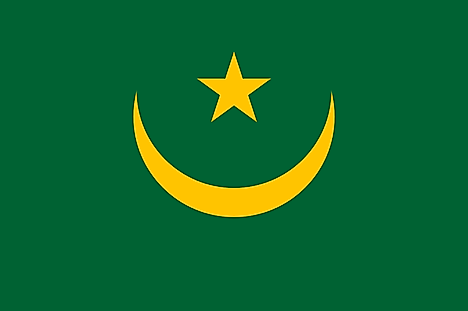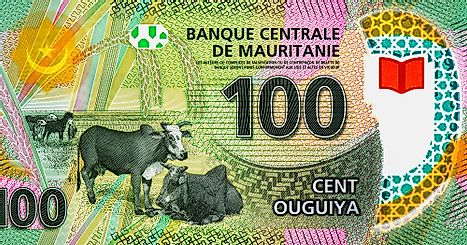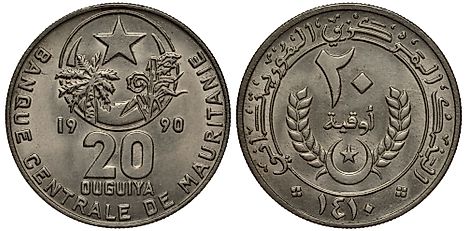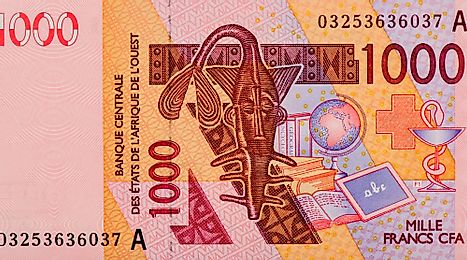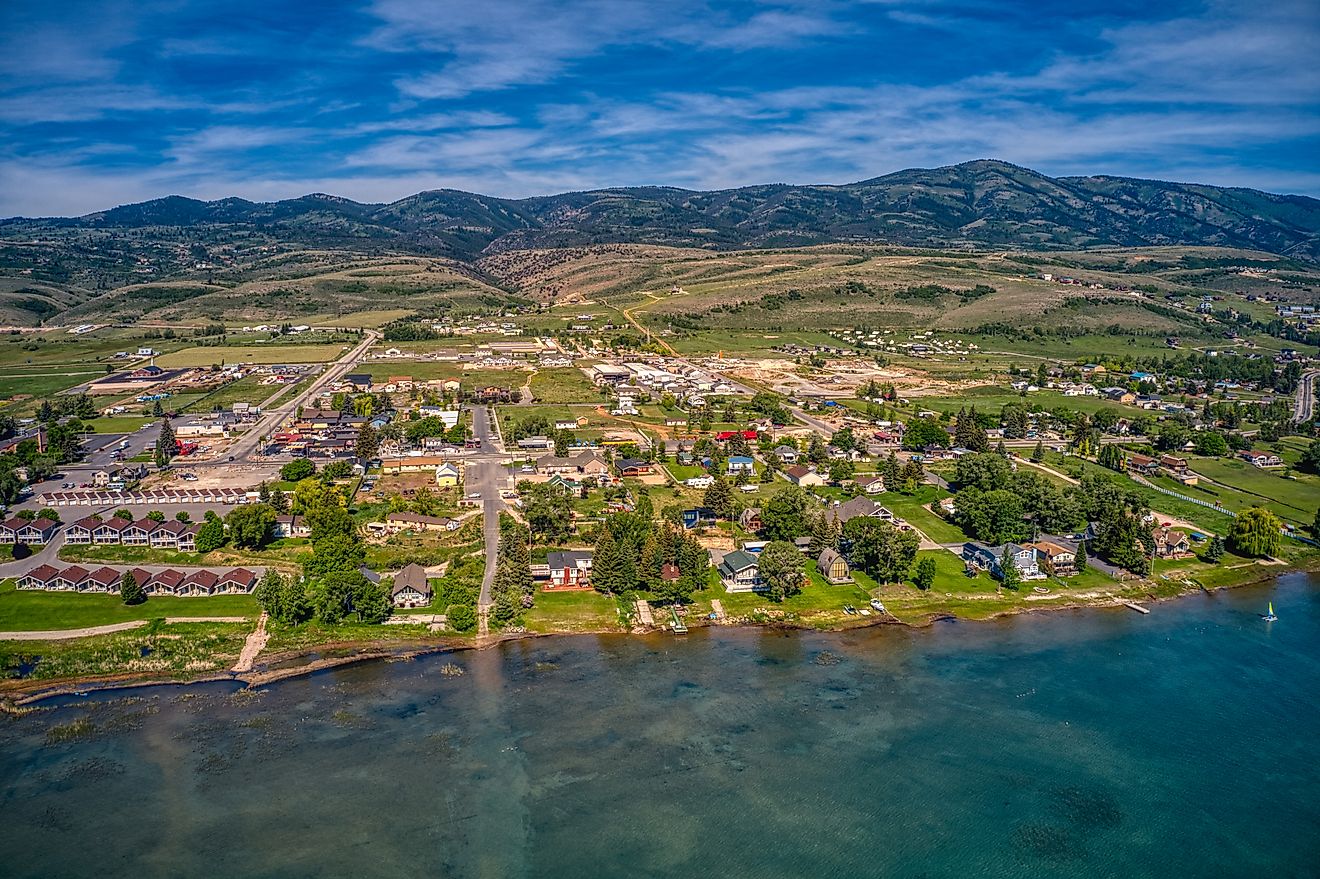Flags, Symbols, & Currencies of Mauritania
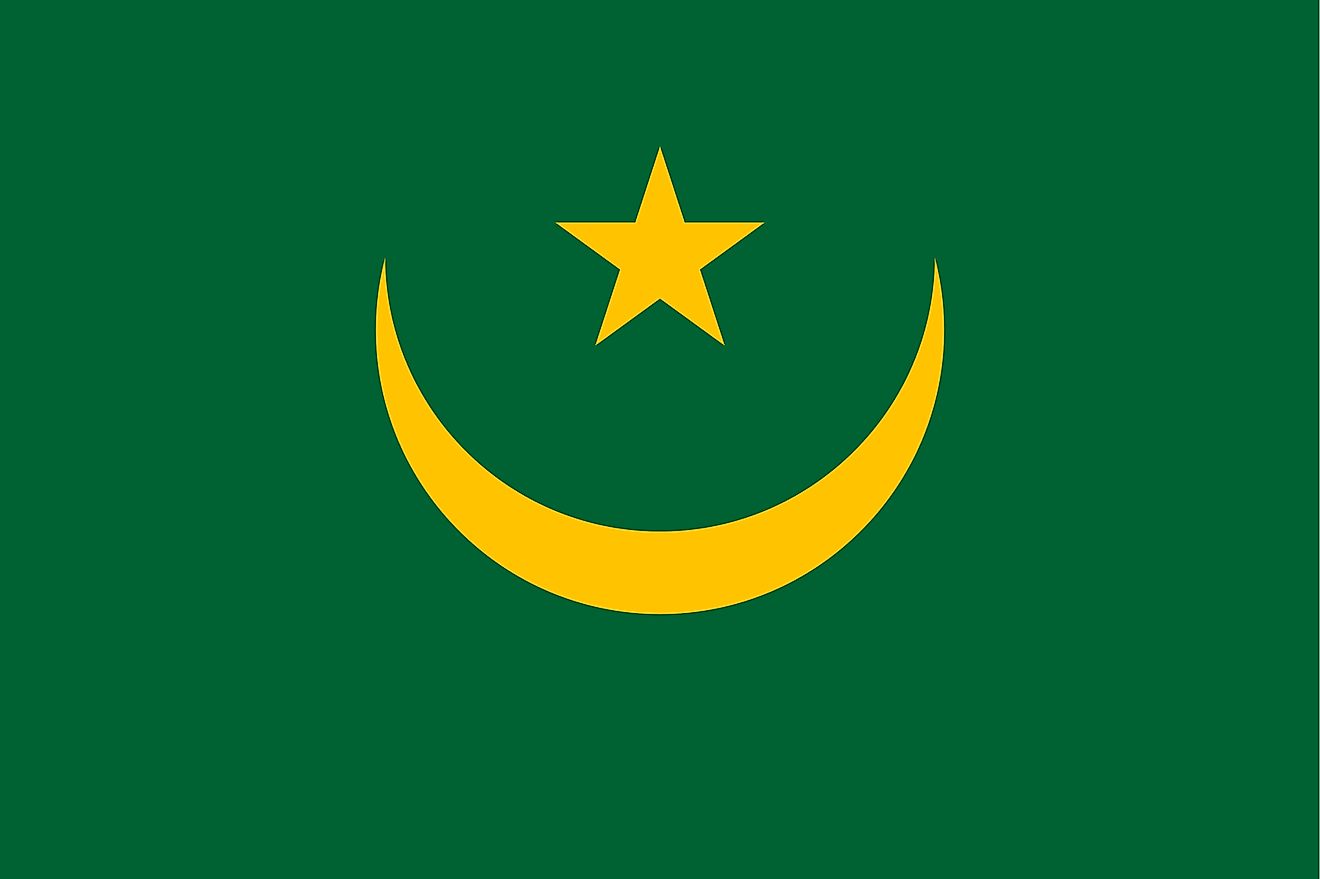
The official flag of Mauritania is made up of three colors. A red stripe runs across the top and bottom of the flag, leaving a green field in the middle. In the midst of the green field is a gold star on top of a horizontal crescent whose tips face upwards. These colors, red, green and gold are considered to be Pan-African colors although they have other meanings. The flag was adopted on August 15, 2017.
The green color in this flag symbolizes Islam, which is the main religion of Mauritania, the gold color symbolizes the sands of Sahara Desert, and the red stripes represent the efforts and sacrifices of Mauritanians to defend their territory, to the price of their blood.
The star and the crescent also symbolize Islam. Since there are two symbols for the country’s state religion, there have been speculations by some writers that the green field in the flag stands for a bright future and growth. The flag measures 2:3 although there lacks a construction sheet or any specification which can give exact relative measurements of the crescent and star. The crescent and a star are common in most countries like Comoros, Turkey, and Tunisia.
History of the Flag
Mauritania’s original flag was introduced on March 22, 1959, under the instructions of the then President Moktar Ould Daddah. It had only the green field with the golden crescent and the star. It was adopted on August 1, 1959. The flag is used as Mauritania’s national flag. Besides, it is used as a military aircraft national insignia in circular form.
The red stripes were added to the flag in 2017. This was after the referendum carried out on August 5, 2017, by President Mohamud Ould Abdel Aziz that sought to abolish the Senate, alter the national flag, and change some aspects of the constitution. The vote was successful, and changes were made before being adopted on August 15, 2017. The red stripes were the only addition to the flag, a gesture of honor to the martyrs who shed their blood 57 years earlier when fighting for their country’s sovereignty from the French.
Symbols of Mauritania
National Coat of Arms of Mauritania
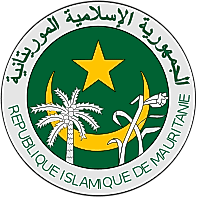
The current national seal of Mauritania was adopted on August 15, 2017, to replace the green and gold seal adopted in 1959. The seal is an adaptation of the national flag and contains the gold, green, and red emblems. It is made up of two circles with gold edges. The inner circle is separated from the outer circle by a red field bearing the country's name: "Islamic Republic of Mauritania" in French (below) and Arabic (above). The inner circle contain cresent, star, palm tree, and millet branch.
National Anthem
- Anthem Title: Bilada-l ubati-l hudati-l kiram" (Country of the Proud, Guiding Noblemen)
- Music composer: Rageh Daoud
- Lyricist: Unknown
- Date of Adoption: November 16, 2017
The national anthem of Mauritania, sometimes referred to as "Bilada-l ubati-l hudati-l kiram" (Country of the Proud, Guiding Noblemen), was adopted on November 16, 2017, to replace Nashid Wataniin Muritaniin ('"National Chant [of] Mauritania). The previous anthem was considered too complex to sing by the majority of the citizens. The new anthem was composed by Rageh Daoud in 2017. It comprises six verses and a chorus, repeated after every verse
Bilada-l ubati-l hudati-l kiram
Bilāda l-ubāti l-hudāti l-kirām
Wa-ḥisna l-kitābi l-ladhī lā yudām
Ayā Mūrītāni rabī'i al-wi'ām
Wa-rukna s-samāḥati thaġra s-salām
Chorus
Sanaḥmī ḥimāki wa-naḥnu fidāki
Wa-naksū rubāki bilauni l-amal
Wa-'einda nidāki nulabbī ajal
Budūru samāiki lam taḥjabi
Wa-shamsu jabīniki lam taġrubi
Namāki l-amājidu min ya'rubi
Li'ifrīqīa l-manba'e l-'adhabi
Ra-ḍha'anā libāna n-nadā wā-l-ibā
Sajāyā ḥamalna janān ṭayibā
Wa-mar 'an ḥaṣībān, wa-in ajdabā
Samaunā, fakāna l-anā ar-ḥabā
Saqainā 'aduaki ṣābān wa-murān
Famā nala nuzulān wa-lā mustaqarā
Nuqāuimuhu ḥaithu jāsa wa-murrān
Nurattilu in-na ma‘a l-‘usri yusrā
Qafaunā ar-rasūl bi-nahjin samā
Ila sidrati l-majd fauqa as-samā
Ḥajaznā ath-thurayyā lanā sullamā
Rasamnā hunalika ḥadda l-ḥimā
Aḥadhnāki 'ahdā hamalnāki wa-'adān
Wa-nhudīki sa'adān lijilin aṭal
Final Chorus
Sanaḥmī ḥimāki wa-naḥnu fidāki
Wa-naksū rubāki bilauni l-amal
Sanaḥmī ḥimāki wa-naḥnu fidāki
Wa-'einda nidāki nulabbī ajal
Country of the Proud, Guiding Noblemen
Land of the proud, the guided and the noble
The fortress of the Book that can't be bound
O Mauritania, the spring of harmony
The corner of tolerance, the haven of peace
Chorus
We will protect you with our lives
and paint your hills with the color of hope
When you call, "yes!" is our answer
The crescent moons in your sky won't wane
and the sun on your forehead won't set
The noble Arabs enriched you
and the purest source is Africa's
We drank the milk of dew and pride
A nature that brought a good harvest
and a fertile pasture, even when it's barren
welcoming us as we ascend
We made your enemy drink a bitter downpour
so he couldn't settle or rest
We resist him wherever he goes
Praying "Surely with hardship comes ease"
We followed the prophet along the path of the heavens
to the tree of glory above the sky
occupying The Pleiades as our stairway
drawing our border there
We took you as a vow and carried you as a promise
we happily give you up to the future generation
Final Chorus
We will protect you with our lives
and paint your hills with the color of hope
We will protect you with our lives
and paint your hills with the color of hope
The Currency of Mauritania is the Mauritania Ouguiya
The Mauritania Ouguiya is the official currency of Mauritania. It is denoted by MRO and divided into 5 khoums (the Arabic word for one fifth) presented by the symbol UM. Ouguiya was adopted as the Mauritania’s official currency in 1973 replacing the CFA Franc, which was the currency used in all the twelve French colonies in Africa. It replaced the French Franc at the rate of 5 to 1. The Khoum and 1 ouguiya are hardly used in Mauritania due to their low value. The Ouguiya is one of the two currencies circulating in the world that is not divided into decimals, the other being Malagasy Ariary.
Coins
Ouguiya coins were introduced in 1973 in various denominations ranging from 1 to 20. The introduction of the coins came a year after the khoums were minted. Khoum was only minted in 1972 because the 1 ouguiya was worth 5 francs, and a khoum was equal to the franc which could not be subdivided further. The latest coins to be minted are the 2003 and 2004 coins which includes 1 ouguiya minted by the Kremnica Mint of Slovakia. In 2009, the coinage slightly changed with the reduction of the 1 ouguiya plated composition and an issue of the bi-metallic 20 ouguiya and a subsequent issue of 50-bi-metallic ouguiya in 2010. These are the only coins in use in Mauritania with the 1 ouguiya having reduced in value thus no longer circulating.
Banknotes
The issuance of banknotes commenced in 1973 with the printing of notes done by the Central Bank of Mauritania in three denominations including 100, 200, and 1000 ouguiya. In 1974, the second printing was done by the Giesecke & Devrient in Munich. In 1979, the 500 note was introduced and the highest denomination, the 5000 note, was introduced in 2009. In 2011, the 2000 note was introduced and circulated. In 2004, new banknotes were printed in different fonts. The vignettes on the back of the notes have been remodeled to accommodate the reduced size of the banknotes. All the notes except for 100 and 200 have Arabic numbers in a holographic patch at right front. The serial numbers have two-character prefix, a seven digit serial number, and one character suffix all appearing on one surface.
Historical Currencies of Mauritania
The current ouguiya replaced the old ouguiya at the rate of 1UM = 10 old ouguiyas. However before ouguiya was adopted as Mauritanian official currency, the country's legal tender was the CFA Franc. The CFA franc is currently the official currency of eight West African countries. The French introduced the Franc in its colonies, including Mauritania, in 1945 to replace the French West African franc. Mauritania continued to use CFA franc even after independence in 1960. However, in 1973, the country abandoned CFA franc for old ouguiya, exchanging 5 franc for 1 ouguiya
